Brazil
Playing card production in Brazil was officially sanctioned by royal decree in 1770.
Playing Cards in Brazil
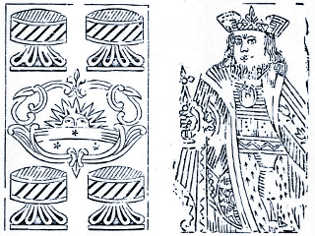
Above: a wood-engraved 4 of cups with the typical Solesio trade-mark suggests a traditional Spanish-suited pack. The single-ended King produced by the Real Fábrica in Rio is from a French-suited pack.
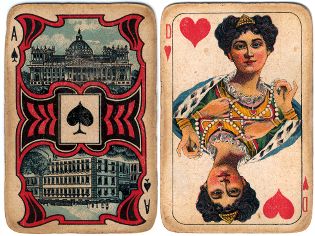
Above: two cards made by Azevedo, Recife, c.1925. Packs with Scenic Aces had been imported into Brazil since the 19th century.
Brazil was officially discovered in 1500 by the Portuguese navigator Pedro Alvares Cabral. Brazil's history encompasses elements from its native culture, from European colonisation and African influences which combine to create the diverse, exciting and vibrant culture that we associate with the country today. Printing in Brazil was controlled by the Portuguese government, although some unauthorised printing did take place. Playing card production in Brazil was officially sanctioned when a royal alvará (charter or document granting certain rights and privileges) of August 8 1770 gave “privileges and tax exemptions to people occupied in making playing cards” in Bahia. A royal decree in 1808 established in Brazil the Real Fábrica de Cartas de Jogar as a part of the Impressão Régia, a similar arrangement as that in Lisbon, for the printing of playing cards.
The monopoly came under treat when clandestine playing card production was discovered in Bahia and its machinery and utensils were confiscated by the Fábrica de Cartas in 1815. Furthermore, playing card smuggling in Bahia was denounced in 1817. In 1818 the Royal Playing-Card Factory was leased to Jayme Mendes de Vasconcelos & Cia. but the contract was cancelled in 1823 due to failure to pay the rent. The monopoly for the playing card trade was abolished the following year. No Spanish-suited court cards from the Real Fábrica have survived. In 1824 Angelo Bissum, Manuel Luiz da Costa and Antonio José Polycarpo were granted permission to open their own playing card factory.
An 1826 newspaper advertisement offered “Portuguese playing cards made in France for the same price as the cards made in Rio de Janeiro”. Various foreign printers and playing card makers are known to have settled in Brazil during the 19th century. Azevedo (“Fábrica Caxias”) and Lafayette were cigarette makers in Recife, Northeast Brazil, at the turn of century. They had a lithographic press to print cigarette labels and also used their machines to make playing cards for some decades. It was probably because of the demise of the Real Fábrica de Cartas de Jogar that Belgian and German manufacturers virtually took over the Brazilian and Portuguese markets, and also brought on the demise of the Portuguese pattern in favour of Spanish, German and English patterns.
Portuguese pattern used in Brazil

Above: stencil-coloured woodblock Portuguese pattern playing cards published in Rio de Janeiro, Brazil, late 19th century.

Above: 48-card Portuguese type playing cards made in or for Brazil, 19th century.
During the late 19th century there was a vogue for playing cards with exotic scenes on the four Aces which continued well into the 20th century. The German manufacturer C.L. Wüst produced a fine Brazil Scenic Aces deck. Many others were produced by Belgian manufacturers and marketed as “Cartes Portugaises ou Brésiliennes”.
Imported cards with scenic aces
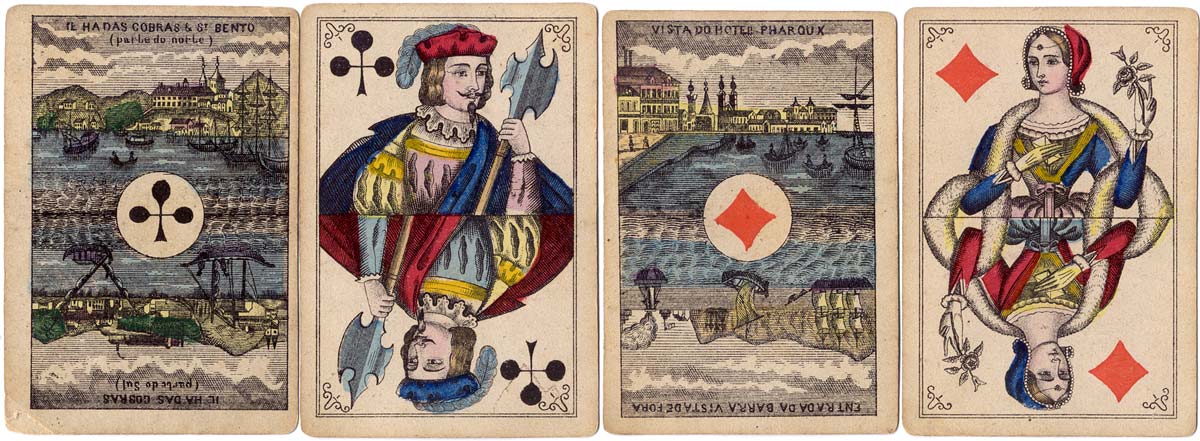
Above: Bongoût pattern playing cards with special scenic Aces for Brazil made by A. Van Genechten, Belgium, 1870. Stencil-coloured lithography. See more →
• See also: Brepols & Dierckx 'Bongoût' with Scenic Aces for Brazil, c.1885 • Brepols & Dierckx Scenic Aces for Brazil, c.1890 • Biermans Scenic Aces for Brazil, c.1920 • Brepols Scenic Aces for Brazil, c.1920 • Brepols Scenic Aces for Brazil, c.1930
The Spanish Cadiz pattern in Brazil
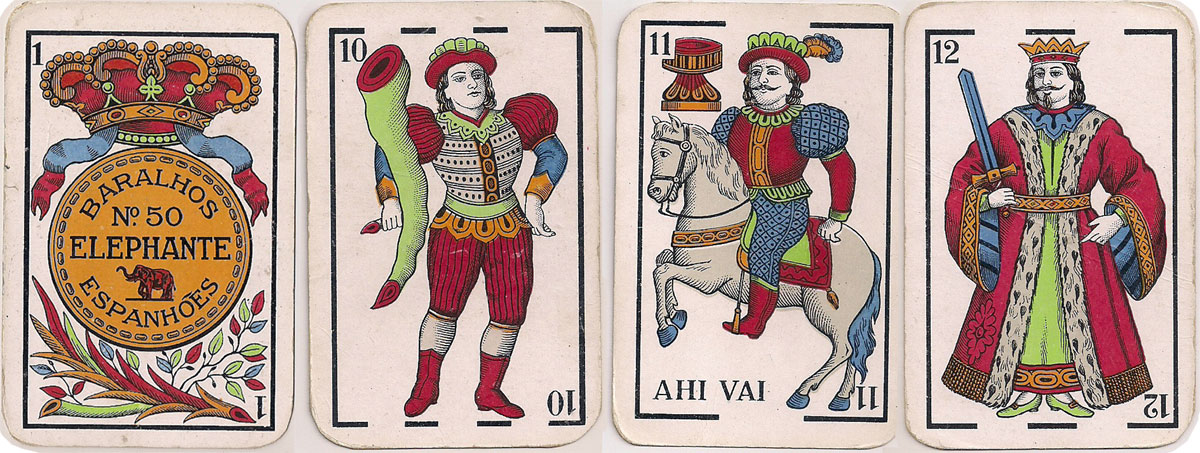
Above: example of Cadiz pattern produced in Brazil, probably by Azevedo & Cia, Recife, c.1920. The “Elephante” brand is an imitation of the Spanish manufacturer Olea’s “Elefante” brand. more →
COPAG (Companhia Paulista de Papéis e Artes Gráficas)
See Copag website article "Cards Used in Brazil"►
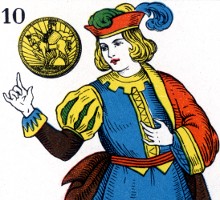
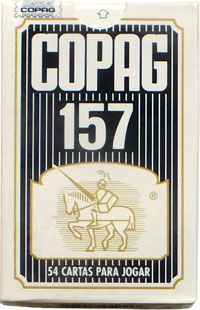
COPAG is the most important Brazilian manufacturer. It was established in 1908 in São Paulo by Albino Dias Gonçalves. At the beginning playing cards were imported and lithographic production started in 1918. Offset machines were acquired in 1930. It is interesting to mention that a decree in 1946 ordered the closing of casinos and prohibited games of chance. In 1987 COPAG’s plant was moved to Manaus, in the Amazon region, a tax-free industrial district, changing its name to the current one, Copag Da Amazônia. In late 1987 COPAG began to export to many countries in Europe, America, Asia and Africa and in 2002, entered the US market, as the culmination of this first international expansion. COPAG is now the market leader and a leading casino playing card supplier in Latin America. At present the “139” card is the company’s leading product. Hotel Amazonas Amazonia Souvenir Copag's Spanish-suited packs →
In 2005 COPAG joined Cartamundi, with 200 years experience in the industry, and the biggest playing card manufacturer in the world. Joining forces with Cartamundi has significantly favoured COPAG’s efforts in the production process and technological development. Copag Celebrates a Century of Success → COPAG Website →
SOIMCA (Sociedade Impressora Caxiense)
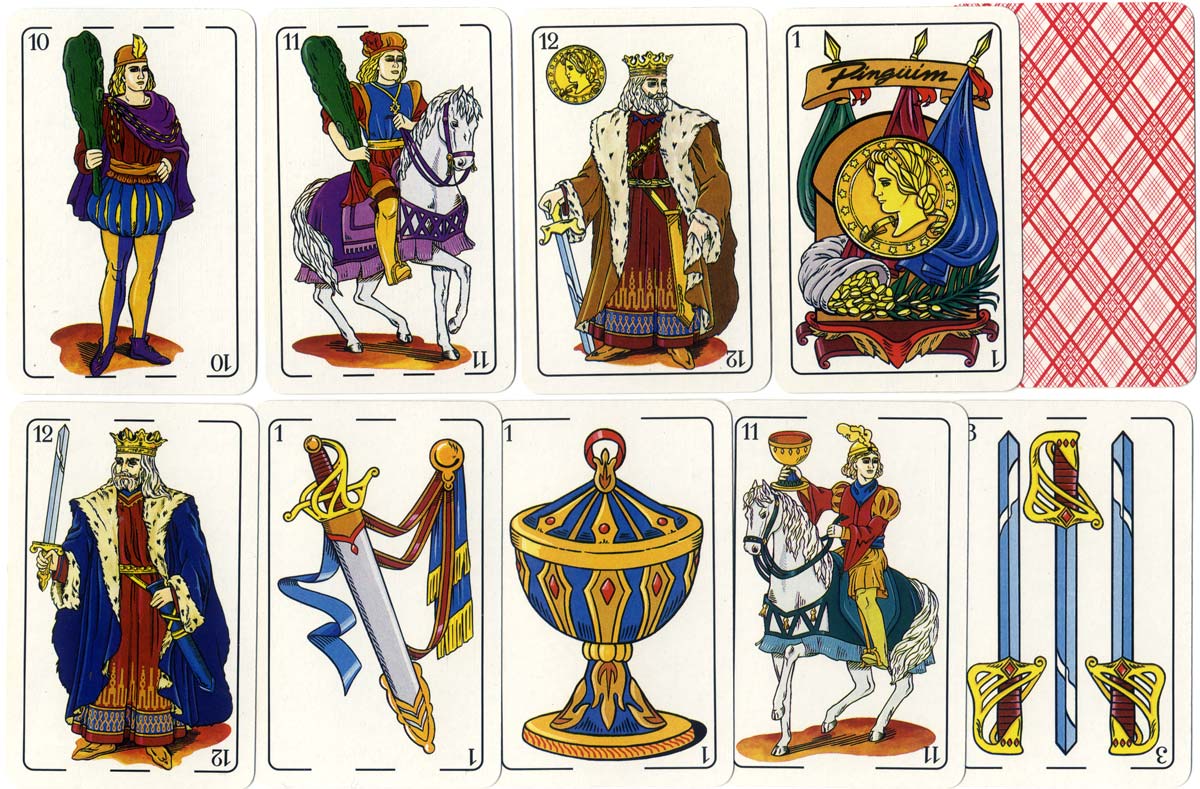
Above: SOIMCA's Spanish-suited deck designed by Gertre inspired by the Castilian pattern, 1993 See more →

SOIMCA (Sociedade Impressora Caxiense) is another important maker. It was established by Nelson Soares in Caxias do Sul, in the south of Brazil, in 1955. Its "Pingüim" brand is very popular. Soimca have produced several Spanish-suited decks, as well as standard Anglo-American decks with or without advertising and packs for foreign markets. Their standard Joker depicts a penguin. In 1999 SOIMCA jointed forces with COPAG, transferring its machines to Manaus.
See also: SOIMCA • Copag's Spanish-suited playing cards • C.L. Wüst: Brazil Scenic Aces • Schincariol Beer • Vale Tudo • Axe Deodorant • Cartografica Industrial • Portuguese Playing Cards

Above: cards from special pack advertising Schincariol Cerveja Pilsen manufactured by Gráfica Nossa Senhora Aparecida Ltda (Nossagraf), Brazil. See more →
Reference: Pagliari, José Luiz Giorgi: Playing-Cards in Brazil - An Introduction, in The Playing-Card, Journal of the IPCS, London, Vol.30, No.6, May-June 2002, pp.247-260
See article “CARDS USED IN BRAZIL” on Copag website ►

By Simon Wintle
Member since February 01, 1996
Founder and editor of the World of Playing Cards since 1996. He is a former committee member of the IPCS and was graphics editor of The Playing-Card journal for many years. He has lived at various times in Chile, England and Wales and is currently living in Extremadura, Spain. Simon's first limited edition pack of playing cards was a replica of a seventeenth century traditional English pack, which he produced from woodblocks and stencils.
Trending Articles
Popular articles from the past 28 days
Related Articles
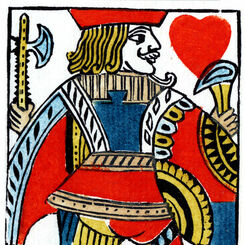
Woodblock and Stencil Jack of Hearts
A limited edition art print of the Jack of Hearts 1984 woodblock joker.
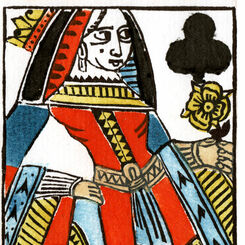
Woodblock and Stencil Queen of Clubs
A limited edition art print of the Queen of Clubs 1984 woodblock joker.
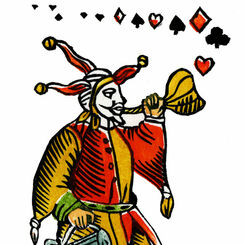
Woodblock and Stencil Joker
A limited edition art print of the 1984 woodblock joker.
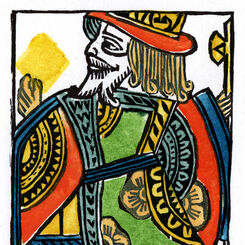
Woodblock and Stencil King of Diamonds
A limited edition art print of the King of Diamonds 1984 woodblock joker.
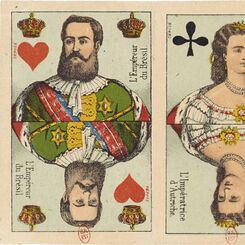
Jeu Quatre Empereurs
Brazilian scenic aces with emperors of Brazil, Austria and France and other dignitaries on the court...
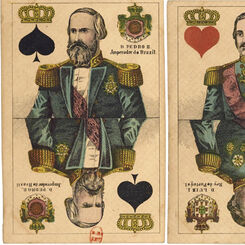
Kings and Queens of Brazil & Portugal
Historical playing cards by C. L. Wüst depicting monarchs of Brazil and Portugal.
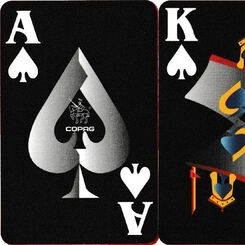
EPOC playing cards
Modern designs by Brazilian artist Maria Leonor Décourt inspired by standard English pattern courts....
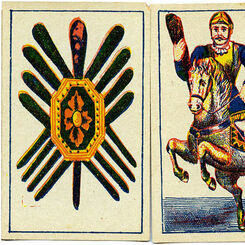
Portuguese cards for Brazil
Portuguese-type cards made in or for Brazil, c.1890.
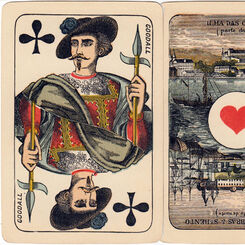
Goodall’s Wüst house pattern playing cards
Goodall’s Wüst house pattern playing cards with scenic aces of Brazil.
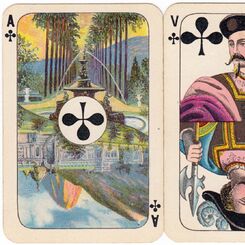
Unnamed Scenic aces of Rio de Janeiro
Cards made by C.L.Wüst of Germany for Brazil
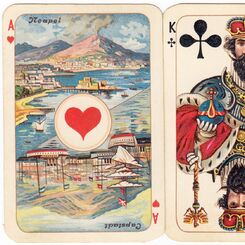
Wüst playing cards with International scenic aces
A rarely seen pack of cards
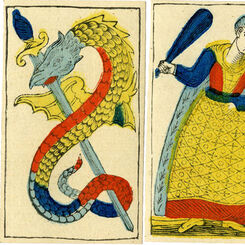
Cartas Portuguezas
Portuguese pattern playing cards published in Rio de Janeiro, Brazil, late 19th century.
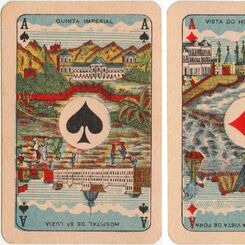
Brazil Pictorial Aces
Genoese pattern with Pictorial Aces for Brazil by Brepols, Turnhout, c.1920.
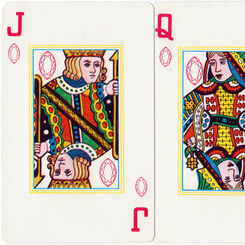
4C Gemstone playing cards for De Beers
4C Gemstone playing cards for De Beers, 1988.
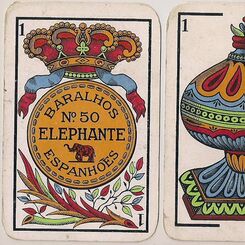
Elephante No.50
‘Elephante No.50’ Cadiz pattern produced in Brazil, probably by Azevedo & Cia, Recife, c.1920.
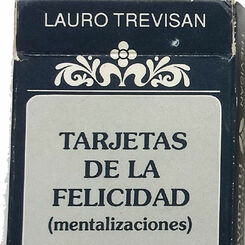
Tarjetas de la Felicidad
“Tarjetas de la Felicidad” containing positive mental affirmations by Lauro Trevisan, Buenos Aires (...
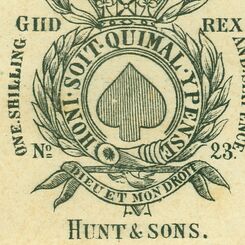
40: More on Design Copies and Fakes
The issue of design copies needs further consideration and when does a copy become a fake?
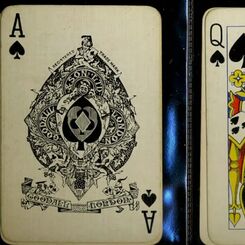
8: Standard English Cards in Latin America: Argentina, Brazil and Chile
A brief survey of the designs of English cards in South America.
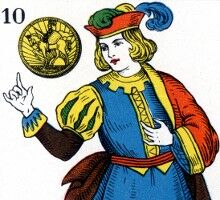
Copag Baralho Espanhol
Copag Baralho Espanhol / Naipes Español.
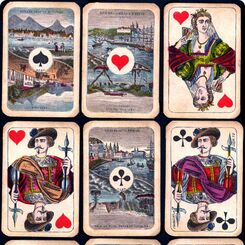
Brazil Scenic Aces
C. L. Wüst Scenic Aces for Brazil.

SOIMCA
SOIMCA - Sociedade Impressora Caxiense - is an important playing card manufacturer in Brazil. It was...

Cartográfica Industrial, Curitiba, Brazil
Double advertising pack made by Cartográfica Industrial for Refrigeração Parana S.A. The extra card ...
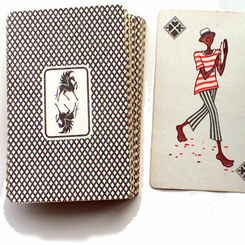
Vale Tudo - Cartas para Jogar
Vale Tudo - Cartas para Jogar, manufactured in Sao Paulo, Brazil. The courts are standard English pa...
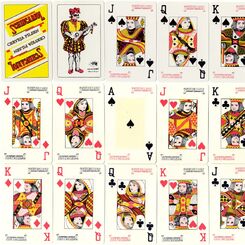
Schincariol Beer, Nossagraf, Brazil
Schincariol Cerveja Pilsen brewery playing cards manufactured by Gráfica Nossa Senhora Aparecida Ltd...
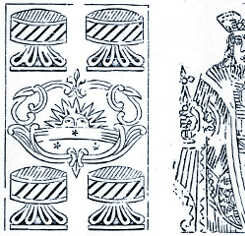
Brazil
Playing card production in Brazil was officially sanctioned by royal decree in 1770.
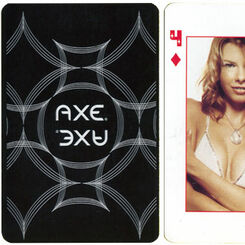
Axe Deodorant
Clearly promoting good personal hygiene, each card shows a young, pouting female model posing seduct...
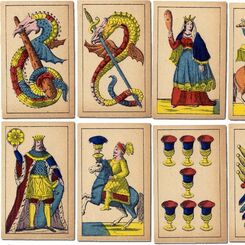
Portuguese Type Playing Cards made in Belgium
Portuguese type pack with ‘dragon’ aces made in Belgium by Mesmaekers Frères, Turnhout, c.1875-1900....

Latin American Playing Cards
Playing cards had been introduced to the Americas with explorers such as Columbus or Cortés, whose f...


